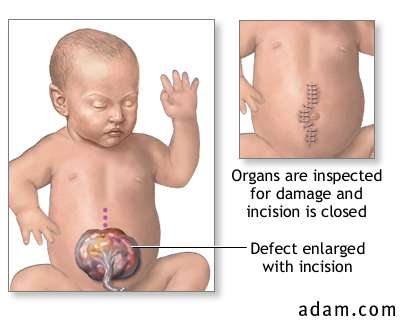|
|
|
Procedure
|

|
|

|
|

|
Immediately after delivery, the exposed organs are covered with warm, moist, sterile dressings. A tube is inserted into the stomach (nasogastric tube, also called NG tube) to keep it empty. This prevents choking on stomach contents or breathing in (aspiration) the stomach contents into the lungs. The surgery is performed as soon as the infant is stable.
While the infant is deep asleep and pain-free (using general anesthesia), an incision is made to remove the sac membrane. The bowel is examined closely for signs of damage or additional birth defects. Damaged or defective portions are removed, and the healthy edges are stitched together. A tube is inserted into the stomach (gastrostomy tube) and out through the skin. The organs are placed back inside of the abdominal cavity, and the incision closed (if possible).
|
|

|
The information provided herein should not be used for diagnosis or treatment of any medical condition. A licensed physician should be consulted for diagnosis and treatment of any and all medical conditions. Copyright 2000 adam.com, Inc. Any duplication or distribution of the information contained herein is strictly prohibited.
|
|